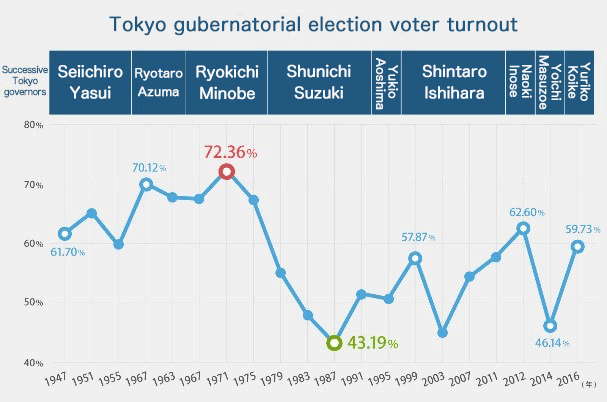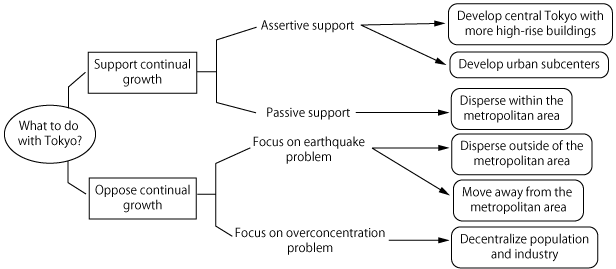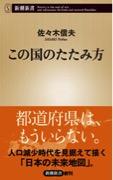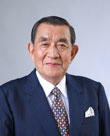2020 Tokyo Gubernatorial Election: A Critical Review
―Questions That Were and Were Not Asked―
Nobuo Sasaki
Professor Emeritus, Chuo University
Areas of Specialization: Public administration, local governmental autonomy
◇ The Race Without Audience Ended
Japan would have been in the 2020 Olympic and Paralympic frenzy right now. People around the world would have travelled here. Between July 24 and September 6, we might have witnessed events so dramatic that we would have almost forgotten how hot the Japanese summer is. We might also have been blown away by the energy coming from heated competition among the best athletes in the world.
Our world, however, turned upside down. We can no longer travel freely domestically or internationally and hear it repeated loudly every day "Don't go outside" or "Don't come to our area." The global spread of the novel coronavirus took away not only the Summer Games but also the norms of our daily living.
Amid all this, there was an election that started and ended without anyone even noticing. I mean the Tokyo gubernatorial election of July 5, 2020. Including the incumbent, there were 22 candidates, which was the most in Japanese history. The showdown in the capital is nicknamed the flower of local elections. Twenty-two candidates made it look like it was true this time too. What it turned out to be, however, was a weak field with a single dominant candidate. No debates on policy or innovation took place. Voters had no opportunity to question the current governor's credentials or understand who she really was. Nonetheless, the current governor, Yuriko Koike, was reelected.
The mass media, without reviewing the four years of her administration also known as the sales copy administration, decided that the coronavirus response and postponement of the Summer Games were the focus of the election. The election ended with that tone. Was that short-sighted focus appropriate? Even if it was, did the mass media explore these focus points? Just like the central government, the Tokyo government threw money around under the name of coronavirus response. Its money--called an "emergency measure"--spread throughout Tokyo, even though direct cash handouts were believed to be ineffective. The candidates demanded an increase in the amount. Didn't the Tokyo gubernatorial election end up being a throwaway match with no debates and no audience? That was my impression of the event.
There have been five Tokyo gubernatorial elections in the past ten years. This is an abnormal frequency. What's more is that five billion yen has been spent for each election. In Japanese, entering an election race is often referred to as shutsu-ba suru (entering a horse race). This time again, 11.44 million eligible Tokyo voters (as of June 1, 2020) spent five billion yen on betting slips and watched the race.
Races being fought neck and neck is the best part of a horse race. In this year's Tokyo gubernatorial race, however, a single horse jumped in front of the others at the starting line. The rest raced as a group. The distance between them grew rapidly. Then, before you knew it, the top runner completed the 17 laps and was being interviewed as the winner, bouquet in hand. There was an overwhelming gap between the mountain of losing race tickets on the street and the smile of the winner who won without even competing. That's how I felt afterwards. I wonder how all of you felt about it.
Tokyo has been unable to use its brain and think due to the coronavirus crisis, but society continues to change regardless. Tokyo has a heap of problems; it is aging with fewer children, its population concentration is growing, the risk of a natural disaster is increasing, and it is being hit by a recession. In the following sections, I would like to deepen my consideration of the future of the Tokyo government administration while analyzing the 21 post-war Tokyo gubernatorial elections.
◇ What Voting Behavior Analysis Tells Us
Let me begin with election analysis. The current governor, Yuriko Koike, was reelected with 3.66 million votes. This was the second most votes for a single candidate ever, less than the 4.33 million votes cast for Naoki Inose (2012), but more than the 3.61 million votes cast for Ryokichi Minobe (1971). Voter turnout this time was 55.00%, which was 4.73 points lower than the previous election (59.73%). This figure, I would say, was unexpectedly high considering that the election took place in an unusual situation due to the pandemic.

In this election, according to an analyst, voter turnout was low for voters in their 20s and 30s while it was high among those who were in their 60s and 70s. Many of these older voters were Koike supporters. Furthermore, approximately 70% of female voters voted for her. The result was her gaining 3.66 million votes, accounting for 59.7% of the total.
In the last Tokyo gubernatorial election (2016) which was a three-way race between Yuriko Koike, Hiroya Masuda, and Shuntaro Torigoe, Koike gained 2.91 million votes. This time, she collected 750,000 more votes. Her votes accounted for 44% of the total last time, and the figure rose to about 60% this time. In this year's election, the three major candidates after Koike, Kenji Utsunomiya, Taro Yamamoto, and Taisuke Ono, together collected 2.12 million votes. With 1.54 million more votes than them altogether, it was a landslide win for her.
Under abnormal circumstances due to the coronavirus crisis, what voters wanted from this election was more of the same rather than change. To be more exact, the same was the only choice available.
One reason was that the election took place amid the raging novel coronavirus pandemic which was spreading globally. People's fear of contracting the virus resulted in the unusually high early voting rate of 15%.
Another reason was that, although it was supposed to be the showdown in the capital, the LDP, the ruling party, did not field any rival candidates and disappeared from the battlefield quite quickly. Where did the LDP go, which fought so hard against Koike four years ago? The same goes for the opposition parties.
Choosing an individual is of course important in an election, but what's more important is the fact that an election is a valuable opportunity to choose a policy. In that sense, the major parties are quite guilty of robbing voters of such an opportunity.
Academics and former bureaucrats used to take office as the Tokyo governor, but recently, former Diet members assume that role. Starting with Yukio Aoshima who was elected in 1995, with the exception of Naoki Inose, all Tokyo governors, Shintaro Ishihara, Yoichi Masuzoe, and Yuriko Koike, were long-serving Diet members, some of whom have lost the LDP presidential election. Because of this, there is a strong impression that the Tokyo metropolitan government has become an offsite battlefield of the national government, a stage for a political performance, and a place for the governor to fulfill his/her political ambition. Am I the only person who feels this way?
Shouldn't we reconsider what the governor of Tokyo should be, the leader who must protect the safety and comfort of Tokyo people?
◇ The Two Issues Tokyo Is Facing
Now, the Koike administration, highlighting coronavirus response as its primary issue, continues. The Tokyo government, however, must deal with more than the coronavirus and issues surrounding the Summer Games. It is not that Tokyo has only one issue right in front of it to deal with; it faces deep and wide underlying structural problems.
In its anti-coronavirus crisis measures, the Tokyo government tends to focus on enhancing the medical system and handing out money to restore the local economy. However, aren't zero COVID patients and returning to a mask-free life what the people of Tokyo wish for? Since the Koike Alert ended, her government seems to only care about strengthening the medical system under the slogan of With CORONA. It does not care if there are 100 COVID patients or 200 of them. This is what the administration wants, but isn't the role of the Tokyo government to use its expertise to try and figure out how to restore life to normal? This should be the real Tomin First (meaning Tokyo people come first).
Can the Tokyo Olympic Games happen next year? Three trillion yen has been spent on the event, and cancellation would result in huge economic damage and rob us of a major means of giving children big dreams. The IOC will decide the fate of the event. In 2016, the Tokyo government promoted the Summer Games as the Reconstruction Olympics, and in 2020 it became the Eco-Friendly Olympics. What is it going to be nicknamed in 2021? Would it be something like the COVID Crisis Exit Olympics? In any case, the purpose of the Olympic Games has become unclear. For the past 10 years, the Tokyo government called itself the Olympics Government and heavily focused on event preparation instead of the citizens of Tokyo. Here, we see the harmful effect of a politician who prioritizes political performance for the international community obtaining the governorship. I think that the administration needs course corrections.
◇ The Three Serious Structural Problems
The year 2020 will be an important turning point for Tokyo in Japanese history. Depopulation is accelerating, and economic growth has ended. For Tokyo and its government, the fundamental task will be to overcome an aging population, population concentration, and the danger of financial collapse.
The first problem is the aging of Tokyo. In five years, all baby boomers will be older than 75. One in four in the population will be 65 or older. Tokyo will have a hard time supporting social security programs such as medical care, nursing care, and pensions. The city once designed as a place for younger generations to live is now rapidly aging. The government must consider how to maintain local economic vitality. Meanwhile, 40% of the elderly population lives alone, and many are renting an apartment. Many also live in neighborhoods crowded with wooden houses connected by a network of tiny alleys.
If in the future pensions are cut and the consumption tax is hiked to impose greater tax burdens on the population, the elderly who can no longer support themselves will start wandering the streets. What would the Tokyo government do about old folk's homes and labor, including the current severe shortages of professional caregivers? The need is growing rapidly for the government to develop a strategy to fully respond to this problem.
At the same time, infrastructure ages too. Around the time of the last Tokyo Olympic Games which was 50 years ago, a vast variety of city infrastructure including roads, ports, bridges, water and sewage systems, elevated walkways, schools, public facilities, subways, railways, and the Tokyo Metropolitan Highway were intensively developed. They are now simultaneously reaching the end of their life cycles (service life: 50 years). Whether through updating or disposal, a huge amount of money and time must be spent. The issue becomes even more complicated because no one knows what the future population will look like, due to depopulation and increased immigration, and how much upgrading is appropriate.
The infrastructure listed above was made with concrete, wood, and iron, meaning it has become fragile. Due to climate change, there have been more local downpours and typhoons. There have been more earthquakes, too. Furthermore, there is a fear of a megaquake in the metropolitan area. One day, suddenly, all the fragility may surface. All infrastructure may collapse at the same time possibly causing a catastrophic disaster. In order to avoid this, the government must pay for and steadily and systematically upgrade the infrastructure to secure Tokyo people's safety and comfort. This is the role of the Tokyo government.
The second problem is the population concentration in Tokyo. How should Tokyo be revived after being damaged by the coronavirus crisis? After experiencing work from home and video conferences, more people no longer feel the need to ride crowded trains to commute to central Tokyo. Under these circumstances, should Tokyo be revived under the assumption that the population will remain concentrated in Tokyo? Or, should it be revived as a "new" Tokyo? Much consideration is necessary.
It is true that Tokyo is the engine of Japan and is the "main breadwinner" that generates 40% of the national tax revenue. Tokyo, the city of 3Cs, however is facing heightened risks; the 23 wards, accounting only for 0.17% of the national land area, have a population of 9.7 million people (as of June 1, 2020), house all high-level central functions, and are crowded with super skyscrapers and apartment buildings. Surely Tokyo has a maximum capacity. I believe it is already over the limit, but where is the real limit?

What should be done with Tokyo? For over 70 years after the war, the Tokyo government always supported the growth of Tokyo into an enormous municipality (see the figure above). From now on, however, a perspective that rejects this growth will be necessary. This means creation of a policy to enhance the quality rather than the volume of Tokyo. There are many ways to do it.
How about a 20% Reduction Policy in which Tokyo will have 20% less people, companies, and universities? They will be relocated to outside Tokyo. The government must seriously implement measures to promote such relocation. A super obese mammoth that can no longer move will die. This is what Tokyo looks like now. Isn't it time for Tokyo to execute a structural change in order to lose weight and transform into a slim and muscular, high-quality municipality? How about making shinkansen tickets and highway tolls virtually free of charge? Japan is a small country with approximately the same land area as the state of California in the US. Fortunately, this small land has three major, well-developed high-speed transportation networks, making a trip from one end to the other short and fast.
It costs money, however. The travel cost deters people from moving. This is where a correction will be effective. My suggestion is to use subsidies from the central or Tokyo government to reduce shinkansen fees and highway tolls to regular transportation fees and tolls. The central government continues to spend five trillion yen per year on regional revitalization. The outcome has been poor. The Tokyo redevelopment cost is even more expensive since it is a small, densely populated, and high land value municipality. Why don't the governments allocate these costs to decentralize the Tokyo population into a wider area? Water finds its own level. Even though the head office of a company is in Tokyo, if its satellite offices are in the urban areas of cities away from Tokyo, younger generations will move to such areas across Japan. The Tokyo area then expands to include Sendai, Niigata, and Nagoya. Similarly, the Osaka area will expand to include Nagoya and Hiroshima. When younger people move, their aged parents go with them. This will mitigate the population centralization of Tokyo.
The third problem is the financial collapse of Tokyo. Traditionally, Tokyo is known as a rich entity and is considered a municipality with no financial worries. Its independent revenue (Tokyo resident tax) has provided 70 to 80% of the total revenue. Tokyo has many corporate head offices and so has high tax revenue during a good economy. Although susceptible to economic fluctuations, two types of local corporate taxes (corporate enterprise tax and corporate inhabitant tax) account for approximately 40% of the Tokyo resident tax. This is why the municipality was rich during the strong economy.
In the first and second emergency coronavirus response measures, the Tokyo government spent 934.5 billion yen (as of the end of March 2020), which was almost all its financial adjustment fund (savings). What will the government do if third or fourth measures are necessary? It is expected that 300 billion yen will be required to clean up after the postponed Olympic and Paralympic Games. If the Games are cancelled, an incomparable amount of money will be required. Meanwhile, it is believed that we will enter a once-in-a-century great recession because of the coronavirus. An unprecedented increase in expenses and decrease in revenues is predicted. With that double whammy, the Tokyo government will have hard-pressed finances.
What will happen when the revenue decreases by one or two trillion yen per year? The resident tax and public utility bills will quickly go up. Based on past experience, 20 to 30% of expenses must be cut to sustain Tokyo's finances. Doing so will create heavy financial burdens on the citizens. Will Tokyo residents approve significant reductions in administrative services and projects? There will also be urgent gross administrative downsizing (administrative reform) such as significant labor reduction and privatization of public corporations such as subways.
The second term of the Koike administration begins on July 31. The new government will enter a very cold winter starting this fall. In Japanese, we have the saying susumu mo jigoku, modoru mo jigoku (advance or retreat, hell awaits). For the past four years, the Koike administration was quite affluent due to special procurement demand for the Summer Games and offered many promises saying "We will do this, we will do that too." Now the situation has completely changed, and the Koike government will need to tackle difficult problems that will come one after another. How will she navigate the challenge? Her skills for managing a large city and her quality and talent as a manager will be tested.
Nobuo Sasaki
Professor Emeritus, Chuo University
Areas of Specialization: Public administration, local governmental autonomyNobuo Sasaki was born in 1948. He graduated from the Graduate School of Political Science at Waseda University and earned his Ph.D. in law at Keio University. After working at the Tokyo Government Office for 16 years, he taught as a professor at Seigakuin University in 1989 and at Chuo University from 1994 to 2018. During this time, he worked as a visiting researcher at the University of California and taught as a lecturer at Keio, Meiji, Nihon, and Saitama Universities. He was a member of the Local Government System Research Council (the 31st term), a member of the Science Council of Japan (the 22nd and 23rd terms), and a special advisor to the Osaka prefectural and municipal governments.
Currently, he is a professor emeritus at Chuo University, a guest professor at the Graduate School of Project Design, the board chairman of the Nihon Kunizukuri Kenkyujo (the Japan Nation Building Research Institute), a special advisor to the Osaka prefectural and municipal governments, a visiting professor at Taiju Soken, and the chief instructor at the Matsushita Institute of Government and Management.

Among his many publications are: Kono Kuni no Tatamikata (How to Reform This Country), Shincho Shinsho; Aratana 'Kuni no Katachi' (The New 'Shape of Japan'), Kadokawa Shinsho; Oiru Tokyo (Aging Tokyo), Kadokawa Shinsho; Chiho Giin no Gyakushu (The Revenge of Local Assembly Members), Kodansha Shinsho; Tochiji (The Tokyo Governor), Chuko Shinsho; and Tocho (The Tokyo Government Office), Iwanami Shinsho.









